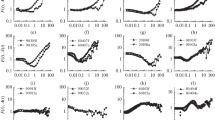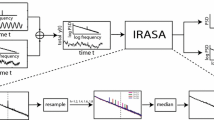Abstract
Current models of the basal ganglia assume a firing-rate code for information processing. We have applied five complementary computing methods to assess firing patterns in 188 cells of the substantia nigra in the anaesthetized rat. Fractal firing activity was found in 100% of nigral cells projecting to the superior colliculus, in 51% of cells projecting to the thalamus and in 33% of cells projecting to the pedunculopontine nucleus, but was practically absent in dopaminergic nigrostriatal neurons (3%). The finding of fractal firing patterns may lead to a better understanding of the normal operational mode and pathological manifestations of the basal ganglia.



Similar content being viewed by others
References
Abarbanel HDI (1996) Analysis of observed chaotic data. Springer, Berlin Heidelberg New York
Abeles M (1991) Corticonics: neural circuits of the cerebral cortex. Cambridge University Press, New York
Alexander GE, Strick PJ, DeLong MR (1986) Parallel organization of functionally segregated circuits linking the basal ganglia and cortex. Annu Rev Neurosci 9:357–381
Allan DW (1966) Statistics of atomic frequency standards. Proc. IEEE 54:221–230
Fano U (1947) Ionization yield of radiations. II. The fluctuations of the number of ions. Phys Rev 72:26–29
Farmer S (2002) Neural rhythms in Parkinson's disease. Brain 125:1175–1176
Faure P, Korn H (1997) A random dynamic component in the synaptic noise of central neuron. Proc Natl Acad Sci USA 94:6506–6511
Garcia-Baez P, Suarez-Araujo CP, Rodríguez J, Rodríguez M (1998) Unsupervised classification of neural spikes with a multilayer artificial neural network. J Neurosci Methods 82:59–73
Gerfen CR, Engber TR, Mahan LC, Suzel Z, Chase TN, Monsma FR, Sibbley DR (1990) D1 and D2 dopamine receptor-regulated gene expression of striatonigral and striatopallidal neurons. Science 250:1429–1432
Goldberger AL (1996) Non-linear dynamics for clinicians: chaos theory, fractals, and complexity at the bedside. Lancet 347:1312–1314
Goldberger AL, Rigney DR, West BJ (1990) Chaos and fractals in human physiology. Sci Am 262:42–49
Gonon FG (1988) Nonlinear relationship between impulse flow and dopamine released by rat midbrain dopaminergic neurons as studied by in vivo electrochemistry. Neuroscience 24:19–28
González-Hernández T, Rodríguez M (2000) Compartimental organization and chemical profile of dopaminergic and GABAergic neurons in the substantia nigra of the rat. J Comp Neurol 421:107–135
Grace AA (1991) Phasic versus tonic dopamine release and the modulation of dopamine system responsivity: an hypothesis for the etiology of schizophrenia. Neuroscience 41:1–24
Hausdorff JM, Peng CK, Ladin Z, Wei JY, Goldberger AL (1995) Is walking a random walk? Evidence for long-range correlations in the stride interval of human gait. J Appl Physiol 78:349–358
Hikosaka O, Wurtz RH (1983) Visual and oculomotor functions of monkey substantia nigra pars reticulata. I. Relation of visual and auditory responses to saccades. J Neurophysiol 49:1230–1301
Liebovitch LS, Töth TI (1990) Using fractals to understand the opening and closing of ion channels. Ann Biomed Eng 18:177–194
Lowen SB, Teich MC (1996) The periodogram and Allan variance reveal fractal exponents greater than unity in auditory-nerve spike trains. J Acoustic Soc Am 99:3585–3591
Lowen SB, Cash SS, Mu-ming Poo, Teich MC (1997) Quantal neurotransmitter secretion rate exhibits fractal behavior. J Neurosci 17:5666–5677
Mandelbrot B (1997) The fractal geometry of nature. Clotet-Tusquets Publishers, Barcelona
Manetti C, Ceruso MA, Giuliani A, Webber CL, Zbilut JP (1999). Recurrence quantification analysis in molecular dynamics. Ann NY Acad Sci 879:258–266
Marsden CD (1982) The mysterious motor function of the basal ganglia. Neurology 32:514–529
Masdeu JC, Alampur U, Cavaliere R, Tavoulareas G (1994) Astasia and gait failure with damage of the pontomesencephalic locomotor region. Ann Neurol 35:619–621
Middleton FA, Strick PL (1997) New concepts about the organization of basal ganglia output. Adv Neurol 74:57–68
Middleton FA, Strick PJ (2000) Basal ganglia and cerebellar loops: motor and cognitive circuits. Brain Res Rev 31:236–250
Obeso JA, Rodríguez-Oroz MC, Rodríguez M, DeLong MR, Olanow W (2000) Pathophysiology of levodopa-induced dyskinesias in Parkinson's disease: problems with the current model. Ann Neurol 47 (suppl. 1):22–34
Parent A, Hazrati L-N (1995) Functional anatomy of the basal ganglia. I. The cortico-basal ganglia-thalamo-cortical loop. Brain Res Rev 20:91–127
Paxinos G, Watson C (1988) The rat brain. Academic Press, Sydney
Redgrave P, Prescott T, Gurney K. (1999) Is the short-latency dopamine response too short to signal reward error?. Trends Neurosci 22:146–151
Rodríguez M, González-Hernandez T (1999) Electrophysiological and morphological evidence for a GABAergic nigrostriatal pathway. J Neurosci 19:4682–4694
Ross GS, Sinnamon HM (1984) Forelimb and hindlimb stepping by anesthetized rat elicited by electrical stimulation of the pons and medulla. Physiol Behav 33:201–208
Schultz W (1998) Predictive reward signal of dopamine neurons. J Neurophysiol 80:1–27
Schultz W, Romo R (1990) Dopamine neurons of the monkey midbrain: contingencies of responses to stimuli eliciting immediate behavioral reactions. J Neurophysiol 63:607–624
Sugihara G, Allan W, Sobel D, Allan KD (1996) Nonlinear control of heart rate variability in human infants. Proc Natl Acad Sci USA 93:2608–2613
Takens F (1981) Detecting strange attractors in turbulence. In: Warwick DA, Young LS (eds.) Dynamical systems and turbulence (Lecture notes in mathematics series, vol. 898). Springer, Berlin Heidelberg New York, pp 366–381
Teich MC (1992) Fractal neuronal firing patterns. In: McKenna T, Davis J, Zornetzer S (eds) Single neuron computation. Academic Press, Boston, pp 589–625
Teich MC, Heneghan C, Lowen SB, Ozaki T, Kaplan E (1997) Fractal character of the neural spike train in the visual system of the cat. J. Opt Soc Am [A] 14:529–546
Terman D, Rubin JE, Yew AC, Wilson CJJ (2002) Activity patterns in a model for the subthalamopallidal network of the basal ganglia. J Neurosci 22:2963–2976
Wichmann T, DeLong MR (1996) Functional and pathophysiological models of the basal ganglia. Curr Opin Neurobiol 6:751–758
Wilson CJ, Young SJ, Groves PM (1977) Statistical properties of neuronal spike trains in the substantia nigra: cell types and their interactions. Brain Res 136:243–260
Zirh TA, Lenz FA, Reich SG, Dougherty PM (1997) Patterns of bursting occurring in thalamic cells during parkinsonian tremor. Neuroscience 83:107–121
Acknowledgements
This work was supported by the Consejería de Educación del Gobierno de Canarias (PI2001/049), and the Ministerio de Ciencia y Tecnología del Gobierno Español (SAF2002-03382 and FISP.I.020194), Spain.
Author information
Authors and Affiliations
Corresponding author
Rights and permissions
About this article
Cite this article
Rodríguez, M., Pereda, E., González, J. et al. Neuronal activity in the substantia nigra in the anaesthetized rat has fractal characteristics. Evidence for firing-code patterns in the basal ganglia. Exp Brain Res 151, 167–172 (2003). https://doi.org/10.1007/s00221-003-1442-4
Received:
Accepted:
Published:
Issue Date:
DOI: https://doi.org/10.1007/s00221-003-1442-4




